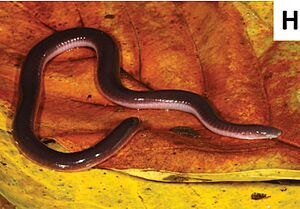Scolecomorphus kirkii facts for kids
Quick facts for kids Scolecomorphus kirkii |
|
|---|---|
 |
|
| Conservation status | |
| Scientific classification | |
| Genus: |
Scolecomorphus
|
| Species: |
kirkii
|
| Synonyms | |
|
Scolecomorphus convexus Taylor, 1968 |
|
The Scolecomorphus kirkii, also known as Kirk's caecilian or the Lake Tanganyika caecilian, is a special type of amphibian. It looks a bit like a large worm or a small snake, but it's actually related to frogs and salamanders! This unique creature lives mostly underground in parts of southern Malawi, northern Mozambique, and Tanzania in Africa.
Contents
Meet Kirk's Caecilian
Kirk's caecilian is named after Sir John Kirk. He was a Scottish diplomat, a scientist who studied nature, and an explorer.
What Does It Look Like?
Kirk's caecilian is the biggest species in its group. Adult caecilians can be from 215 to 463 millimeters long. That's about the length of a school ruler or a bit longer! They have 130 to 152 ring-shaped folds all along their body.
Their back and sides are a lavender-grey color. Their belly is a lighter cream color. Scientists think their bright colors might be a warning sign to predators. This is called aposematic coloration, which means "stay away, I might be dangerous!"
Life Underground: Habits and Reproduction
Kirk's caecilian is very good at burrowing. It spends most of its life hidden in the soil. It eats small creatures like insects and other arthropods that live underground.
Unlike many amphibians, Kirk's caecilian does not need water to lay its eggs. It is thought to be viviparous, which means the mother gives birth to live young. This is quite unusual for an amphibian!
Sometimes, Kirk's caecilian can become food for other animals. For example, a type of snake called Atractaspis aterrima has been found with Kirk's caecilians in its stomach. This snake also lives underground.
Where It Lives and How It's Doing
Kirk's caecilian lives in forests on mountains and hills. It usually prefers places that are high up, often above 1,000 meters (about 3,280 feet) above sea level. But sometimes, it can be found in lower areas too, around 500 meters (about 1,640 feet).
These caecilians can also live in places changed by humans, like fruit gardens and small farms. They seem to be quite common in the areas where they are found.
Conservation Status
The International Union for Conservation of Nature (IUCN) has looked at Kirk's caecilian. They have decided it is a species of "Least Concern". This means that, for now, there are enough of them, and they are not in immediate danger of disappearing.
However, their homes can be affected by people cutting down forests or changing land for farming. While these things could be a problem, scientists are not sure if they are a big threat right now. Kirk's caecilian is also sometimes seen in the pet trade, but this is very rare.


